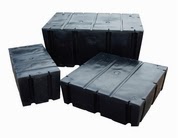Building your first
floating boat dock is fairly self-explanatory for the most part. All you really need is a few basic tools and one or two of your brute friends. However the one thing that HarborWare's customers have the most questions about is the
dock floats, how many they need and what size. Hopefully this page will answer all of the questions you may have.
How Many Dock Floats Do I Need?
Unless you're building a very small swim platform, you're going to need a minimum of 3 float drums: 1 for each dock-end and 1 in the middle (if you're building a straight floating pier for example). However, you may need 10 floats or even 50 if you're building something more complex like a U-Shaped boat slip or small neighborhood marina. On average we sell around 10 floats per small lake house dock. For marinas, it ranges from 24 to 240.
How Much Buoyancy Do I Need?
For a Residential Dock built with aluminum or wood frames, wood or plastic decking, and no roof: calculate your square footage, multiply it by 30 (estimating 30lbs. per sq/ft). You never want to estimate the rock-bottom, bare minimum buoyancy needed and have your floats completely submerged under water. They can run the risk of collecting water or moisture if this happens.
For a Heavy-Duty Residential Dock or Commercial Dock with steel frames, concrete decking and a roof: calculate your square footage, multiply it by 40 (estimating 40lbs. per sq/ft).
Residential 4'x40' Dock
4 x 40 = 160
160 x 30 = 4,800 estimating 30lbs pr/sqft |
|
Commercial 4'x40' Dock
4 x 40 = 160
160 x 40 = 6,400 estimating 40lbs pr/sqft
|
What Size Dock Float Do I Need?
It depends on the width and length of your boat dock. Generally if your dock is 4' wide, you'll wan't a 4' float drum, whether the float drum is 4'x4'x16" or 2'x4'x16". In some cases it doesn't matter, such as if your dock is 20' wide by 20' long. Since we don't make a 20' float drum you can essentially use any size float on both ends as long as you're using adequate buoyancy.
As far as height, it's all a matter of preference. However most of the time Residential docks use 12" to 20" tall, while Commercial docks use 20" floats or taller.
What All Can I Build With Dock Floats?
Here is a list of all the things customers have used our float drums for:
- Boat Docks
- Boat Lifts
- Floating Boat Houses and Cabins
- Duck Blinds
- Oyster Farms and Hatcheries
- Industrial Agitators
How Much Is Shipping?
Most float drums must be shipped by freight truck and this can sometimes cost 25% of the total order. We suggest ordering at least 4 floats of any size because the cost to ship 1 or 2 is about the same as 4. Most sizes require freight truck shipping and they only ship by the pallet load.
Keep in mind
we are the manufacturer, so even after shipping we're usually 20% less than a distributor's price, even if they claim to offer "free shipping." Also, we only have to charge sales takes in 4 states (AR, MO, OK, AL).
Why Can't I Use Foam Blocks or 55 Gallon Barrels Instead?
Unfortunately both are illegal in most states. The Environmental Protection Agency banned raw foam because overtime pieces break off and end up getting eaten by wildlife and polluting lakes. 55 gallon barrels were banned because they may have been previously used to store harmful chemicals. Getting caught using either one of these can result in hefty fines that are far greater than the cost of plastic encased dock flotation. On one lake we heard the fines were $1,000 per day.
Can you keep Dock Floats in Frozen Lakes?
Yes, but only if they're foam-filled. All HarborWare and Insul-Bead Corp dock floats we manufacture are foam-filled and are safe to keep in lakes and bays that freeze over in the winter. “Tests have shown that when foam-filled drums are left in the water over winter, the ice forming along their bottoms is thinner than ice surrounding the float. The insulating qualities of the foam are credited with preventing the ice from forming. Together, the greater strength and lesser ice buildup seem to give foam-filled drums an advantage for icebound floating docks.” – The Dock Manual by Max Burns, Page 33, Published January 4, 1999
If you have major ice shifting on your water, you may consider moving the dock out to avoid it getting hit. Shifting ice can sometimes be 5 miles wide and will destroy any structure in its path.
By: Dave Darr






